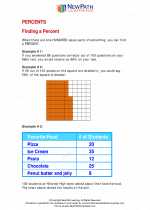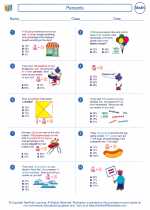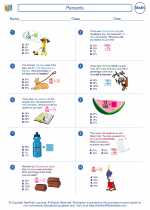Percents
Percents are a way of expressing a number as a fraction of 100. The word "percent" means "per hundred." We use percents to compare and represent proportions of a whole. For example, if 30 out of 100 students in a class are girls, we can say that 30% of the class is female.
Converting between Percents, Decimals, and Fractions
It's important to be able to convert between percents, decimals, and fractions. Here are the basic conversions:
- To convert a percent to a decimal, divide by 100. For example, 25% becomes 0.25 as a decimal.
- To convert a decimal to a percent, multiply by 100. For example, 0.6 becomes 60% as a percent.
- To convert a percent to a fraction, write the percent as a fraction with a denominator of 100, and then simplify if possible. For example, 75% becomes 75/100, which simplifies to 3/4.
- To convert a fraction to a percent, divide the numerator by the denominator, then multiply by 100. For example, 2/5 becomes (2 ÷ 5) × 100 = 40%.
Calculating Percentages
To calculate a percentage of a number, you can use the formula:
Percentage = (Part / Whole) × 100
For example, if you want to find 20% of 150, you would use the formula:
20% of 150 = (20/100) × 150 = 0.20 × 150 = 30
Applications of Percentages
Percents are used in many real-life situations, such as calculating discounts, interest rates, and proportions. It's important to understand how to use percents in different contexts to solve problems and make informed decisions.
Study Guide
To master the topic of percents, it's important to practice converting between percents, decimals, and fractions. You should also work on calculating percentages of numbers and solving word problems involving percentages. Here are some key concepts to focus on:
- Converting between percents, decimals, and fractions
- Calculating percentages of numbers
- Solving word problems involving percentages
- Understanding real-life applications of percentages
By practicing these skills and concepts, you'll develop a strong understanding of percents and be able to apply them to various mathematical and real-world situations.
.◂Math Worksheets and Study Guides Fourth Grade. Percents

 Worksheet/Answer key
Worksheet/Answer key
 Worksheet/Answer key
Worksheet/Answer key
 Worksheet/Answer key
Worksheet/Answer key
